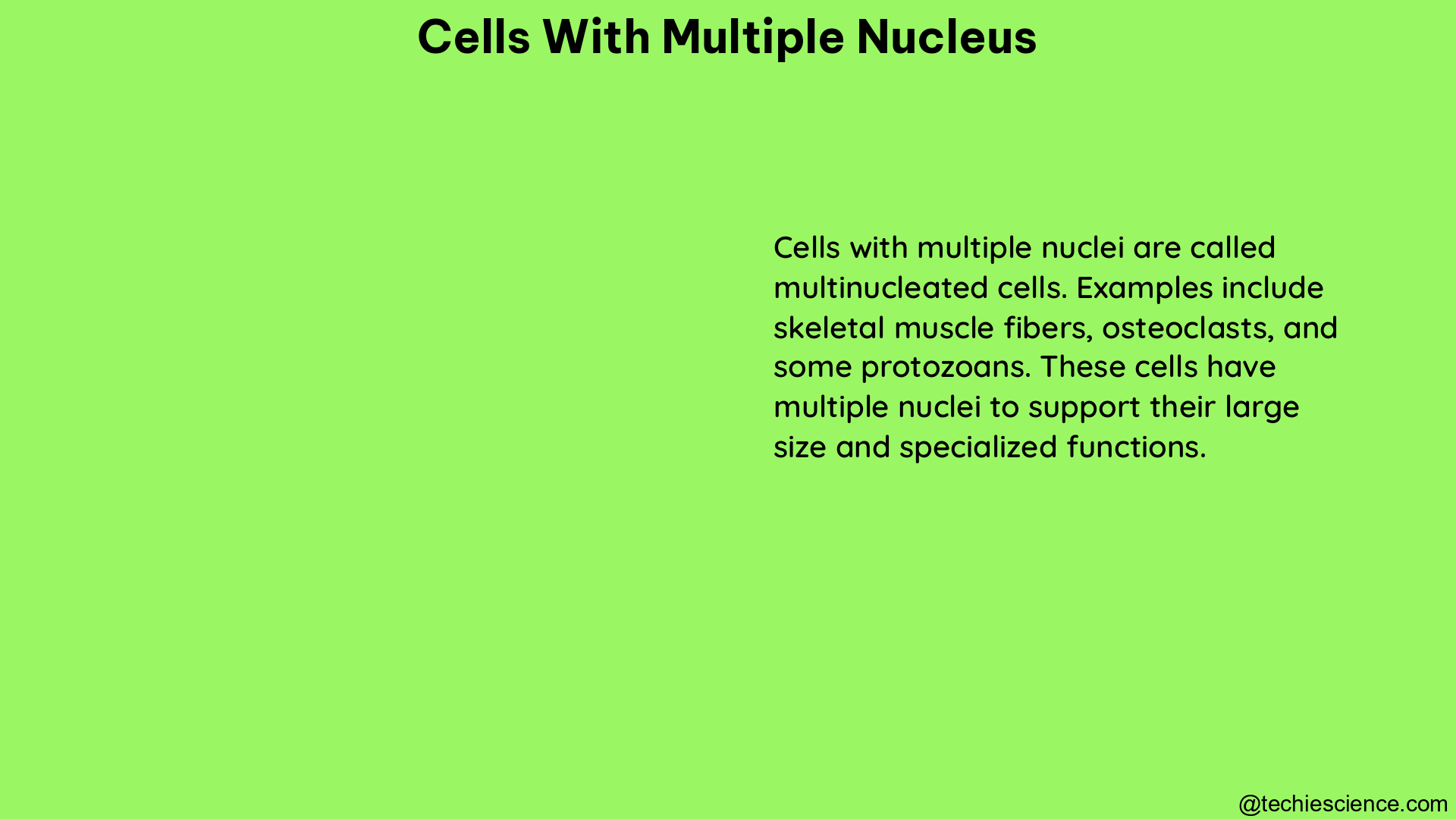Cells with multiple nuclei, also known as multinucleated cells, are a unique and intriguing phenomenon in the world of biology. These specialized cells, found in various tissues and organisms, possess the remarkable ability to harbor more than one nucleus within their cytoplasm, setting them apart from the more common single-nucleus cells. Understanding the characteristics and quantifiable data associated with these cells is crucial for researchers and biologists alike, as they provide valuable insights into cellular structure, function, and development.
Nuclei Count per Cell: Unveiling the Complexity
One of the fundamental measurements for multinucleated cells is the number of nuclei present within a single cell. This can be determined using advanced image analysis software, such as CellProfiler, which can accurately identify and count the nuclei. Studies have revealed that the number of nuclei per cell can vary significantly, depending on the cell type and the biological context.
For instance, in a study of retinal pigment epithelial (RPE) cells, the number of nuclei per cell was found to typically range from 1 to 2 in wild-type cells. However, in certain pathological conditions or genetic manipulations, the number of nuclei per cell can increase dramatically. In a study of RPE cells with a specific genetic knockout, the number of nuclei per cell was observed to range from 1 to as many as 8, showcasing the remarkable plasticity of these cells.
Cell Area and Perimeter: Quantifying Size and Shape

The size and overall morphology of multinucleated cells can also be quantified using image analysis tools. CellProfiler can measure the area and perimeter of cells, providing valuable information about their size and shape. This data can be particularly useful in understanding the relationship between cellular structure and function.
In the RPE cell study mentioned earlier, the area of wild-type cells was found to be relatively uniform, with a mean area of approximately 1,500 square micrometers. In contrast, the knockout cells exhibited a wider range of areas, with some cells reaching over 3,000 square micrometers. This variability in cell size and shape can be indicative of underlying cellular processes, such as altered cytoskeletal organization or changes in cell-cell interactions.
Nuclei Size and Shape: Unveiling Intracellular Dynamics
The size and shape of individual nuclei within multinucleated cells can also be quantified using image analysis tools. CellProfiler can measure the area, perimeter, and various shape descriptors, such as circularity and solidity, for each nucleus. This data can provide insights into the organization and distribution of genetic material within the cell.
In the RPE cell study, the nuclei in wild-type cells were found to be relatively uniform in size and shape, with a mean nuclear area of approximately 100 square micrometers and a high degree of circularity. However, the knockout cells exhibited a wider range of nuclear sizes and shapes, with some nuclei becoming elongated or irregularly shaped. These changes in nuclear morphology can be indicative of altered cellular processes, such as changes in chromatin organization or nuclear-cytoplasmic interactions.
Nuclei Intensity and Texture: Probing Intranuclear Dynamics
The intensity and texture of nuclei staining can provide valuable information about the distribution and organization of nuclear material within multinucleated cells. CellProfiler can measure various intensity and texture features for each nucleus, such as mean intensity, standard deviation of intensity, and various texture measures (e.g., Haralick features).
In the RPE cell study, these intensity and texture features were used to characterize the distribution of a specific transcription factor, Forkhead protein, within the nuclei of cells treated with a drug known to induce cytoplasm-nucleus translocation. The changes in nuclear intensity and texture patterns observed in the treated cells provided insights into the dynamic localization and activity of this important regulatory protein.
3D Nuclear Morphometry: Unveiling the Complexity of Nuclear Architecture
For a more comprehensive analysis of nuclear morphology, advanced techniques such as 3D shape modeling and morphometry can be employed. These methods involve the reconstruction of the 3D structure of nuclei and the application of geometric morphological measures to quantify their shape and size.
A study using robust surface reconstruction and geometric morphological measures achieved high accuracy in classifying sets of prostate cancer and fibroblast cells based on their nuclear morphology. This approach revealed subtle yet significant differences in nuclear architecture that could not be captured by traditional 2D analysis methods.
The application of 3D nuclear morphometry to the study of multinucleated cells can provide an even deeper understanding of their complex intracellular organization and the relationship between nuclear structure and cellular function.
Conclusion
Cells with multiple nuclei, or multinucleated cells, are a fascinating and complex subject of study in the field of biology. By leveraging advanced image analysis tools and techniques, researchers can quantify a wealth of data related to these unique cells, including nuclei count, cell size and shape, nuclei size and shape, nuclei intensity and texture, and even 3D nuclear morphometry.
This comprehensive understanding of the measurable and quantifiable characteristics of multinucleated cells can provide valuable insights into their structure, function, and role in various biological processes. As research in this area continues to evolve, the knowledge gained from these studies will undoubtedly contribute to our broader understanding of cellular biology and its implications for human health and disease.
References:
- Lamprecht, M. R., Sabatini, D. M., & Carpenter, A. E. (2007). CellProfiler: image analysis software for identifying and quantifying cell phenotypes. Genome biology, 8(3), R100.
- Counting multinucleated RPE cells
- Krysan, P. A., Kozubek, P., & Collins, A. (2018). 3D shape modeling for cell nuclear morphological analysis and classification. Scientific reports, 8(1), 14130.

Hi, I am Milanckona Das and pursuing my M. Tech in Biotechnology from Heritage Institute of Technology. I have a unique passion for the research field. I am working in Lambdageeks as a subject matter expert in biotechnology.
LinkedIn profile link-